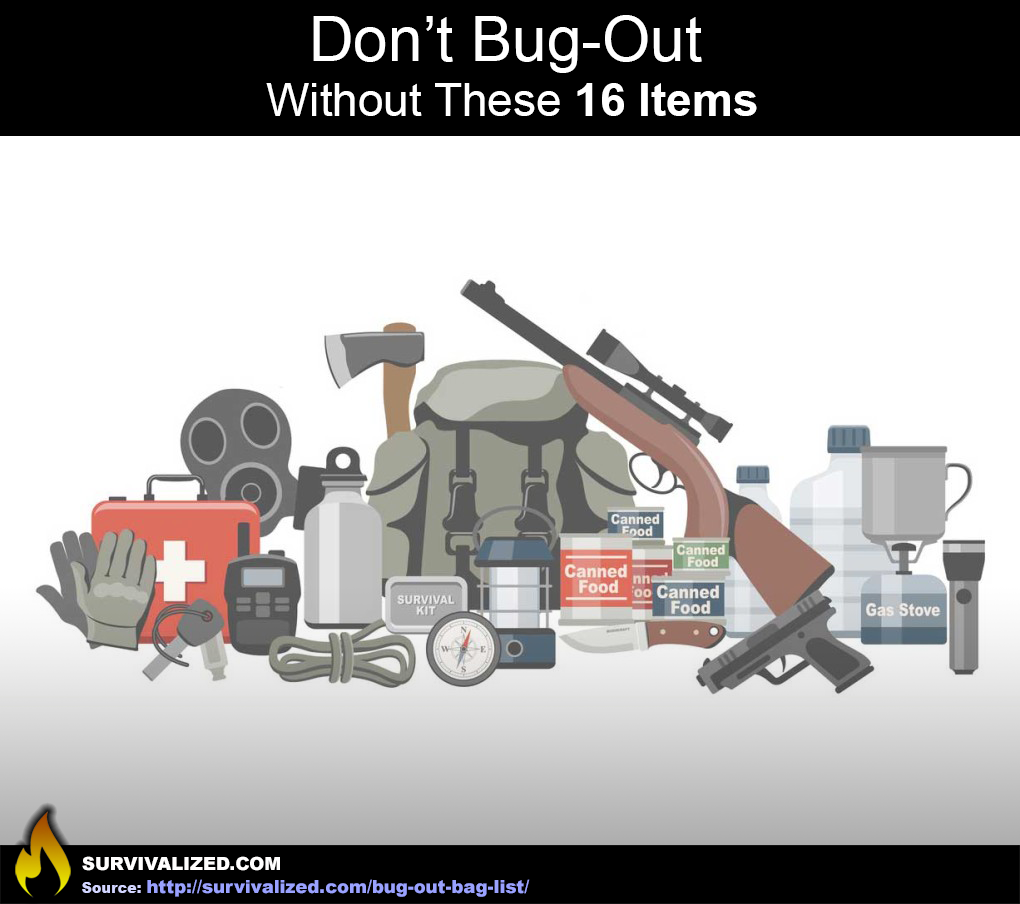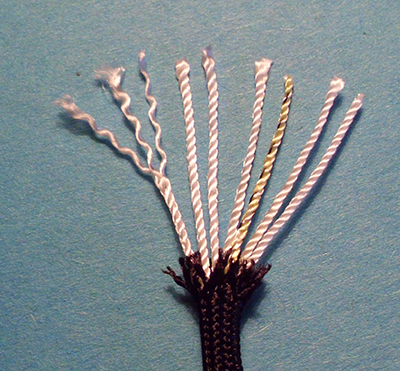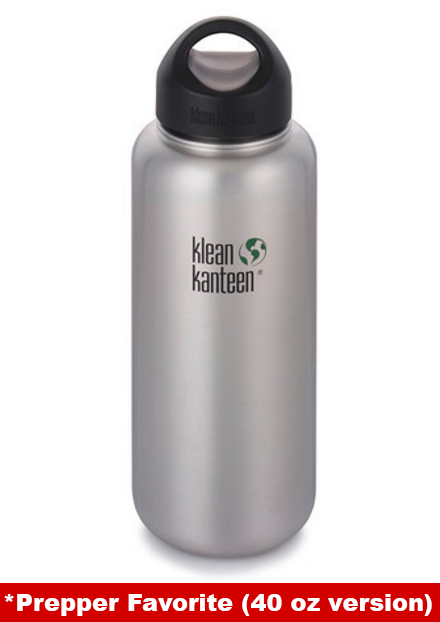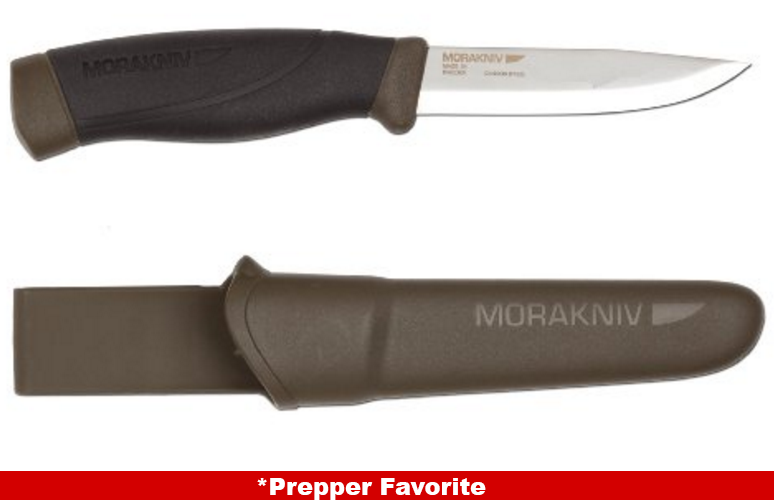
A bug out bag list is important if you are serious about survival! An emergency can happen at a moment's notice, and your bug out bag may be essential to saving your life. But what needs to be in it? There are SO many items you could pack, but you need to be able to carry that sucker!
This is a list of essential items for your bug out bag. I’ve also added links in many cases to highly recommended items used by survivalists and preppers to save you research time. Bug out plans vary, but this list should be a good core bug out bag list.
1. High Quality Water Bottle
Water is critical in a crisis situation. You won't last long without it. A common favorite water bottle of preppers is the stainless steel klean kanteen in the 40 oz size. They are rugged and since they are made of food grade stainless steel you can actually boil water in them, where many other brands are made of aluminum and baked epoxy.
2. Water Purification
Even if you are just bugging out for 72 hours you are going to need to refill your water bottle, and drinkable water may not be available to you. You can always boil your water, but it’s better to have a water filtration system on hand. A couple of prepper favorites are the Acquapura Personal Water Filter and LifeStraw. They are small, light, and filter quickly. Below is a video that shows how the LifeStraw works.
3. Survival Food
A bug out bag list essential is food! You will need food to keep your energy up! What you pack will depend on your preferences, but here are some popular items for your bag:
- MRE’s (Meals Ready to Eat) - These are quick and don’t require cooking.
- Protein bars - Packing your favorite protein bars is always a good idea.
- Dehydrated meals - Light and easy to carry but require water and heat. There are many different brands to choose from but one of the most popular is Mountain House.
4. Survival Knife
A good knife is essential for surviving outdoors. The basics for what to look for in a good survival knife are:
- able to hold an edge (ie. carbon steel)
- a full tang (blade extends all the way through the handle as one piece)... not a folding knife!
- a blade that is 4-7 inches in length
Bonus features:
- A flat butt for hammering is a nice additional feature, although not essential
- It’s also nice to have a saw on the back side but again, not essential
Survival knives can range from $10-$300 give or take. A couple of well known and well reviewed ones at an affordable price point are the KA-BAR Black Straight Edge Knife (company link) and the Gerber Bear Grylls Ultimate Knife (company link). Both can be found on Amazon for much cheaper than their list price.
(Update) At this point I have seen so many reviews about Mora knives and how great they are for the money, that I am adding the Mora Companion Heavy Duty to the list . I mean for $15 bucks how can you go wrong!
5. Fire Starter
The best survival fire starters are flint based simply because it is extremely durable and holds up under wet circumstances. It is a must-have for your bag! You may want to carry a lighter or matches as well just to make starting a fire easier, but it is definitely not necessary.
Here are a couple affordable flint based ones to consider:
- BlastMatch (one handed leaving the other free, which can be really handy!)
- Rothco Aurora (super compact and well built)
6. Tent or Tarp
As every survivalist will tell you, shelter is key, so you will definitely need something to protect you from the elements. A tarp will be lighter and take up less space, while a tent will shelter you from drafts and will keep the bugs out. My personal choice is a tent since I like to avoid misery if at all possible, but it will cost more, unfortunately. I would provide a few links but there are SO many that are available that I will let you do the shopping. When shopping, consider whether you want to be seen or not. If you want to be rescued choose a bright color. If not, go camo : )
7. Camping Cookware
Things to be aware of when shopping for a camping pot:
- Get something with a rounded bottom for easier cleaning.
- Make sure the lid fits tight. Your food will cook faster.
- Stainless or Titanium are more resilient.
The Cadillac of camping pots would be the super light titanium Ti Ultralight Pot ($47). Best bang for your buck would be the stainless MSR Alpine Stowaway Pot ($15)
You'll also need a fork and spoon. There are tons of these to choose from on the market. My personal choice is this titanium spork : )
Something that is not essential but is helpful and super cool is the Solo Stove although it is expensive ($70). What makes Solo Stove so unique is that it uses whatever you can find as fuel (ie. leaves and sticks). It is much more efficient than a campfire and you don't have to carry fuel such as alcohol or propane. The below video is a Solo Stove review/field test.
8. Rain Gear
Getting wet poses all kinds of problems when trying to survive in the wild. You need to make sure you have a rain jacket, shell, or poncho in your bag. A poncho can also be used as a shelter as well which adds some cool functionality. Also, Zip Lock bags work great for protecting the smaller items inside your bag.
9. Paracord (Parachute Cord)

Paracord (short for parachute cord) is a durable lightweight nylon cord used with parachutes. Because it is light and strong it works great as a survival cord as well. Paracord can be used in many ways in a survival situation such as:
- Tying a shelter together
- Securing gear
- Repairing items
- It can be unraveled and the smaller “yarns” of the core can be used as thread for sewing
- These smaller threads can be used for fishing as well
Paracord can be carried in your bag, used as shoe laces, or woven into a bracelet, belt, or lanyard.
*reference: https://en.wikipedia.org/wiki/Parachute_cord
10. Hatchet
A hatchet is extremely helpful for breaking up firewood and gathering limbs for fashioning a shelter. The back of the hatchet can also be used as a hammer. A saw is also really useful for cutting small limbs.
A survival hatchet is more durable, but also weighs a little over a pound, compared to a 9" folding saw which weighs closer to a third of a pound and takes up about a third the space.
Since your bug-out bag is primarily focused on short term survival (hopefully 72 hours or less,) and keeping the weight down is critical, your best bet is likely the folding saw.
Some highly rated survival axes and folding saws are as follows:
11. Compass & Maps
Remember that in a disaster situation you will likely not be able to rely on your phone, and if you are unfamiliar with the area you will end up having a tough time finding your way around. A good map and a compass can be a life saver!
A couple of highly rated compasses are:
12. Documents
You may want to carry select important documents with you. Storing your most important documents on a USB drive is probably your most portable option.
13. Change of Clothes
Generally survivalists carry one extra set of clothes with them. The clothing you choose will vary depending on the climate you live in. Here are some important clothing items to consider:
- Durable pants with pockets
- Rain jacket or poncho as mentioned above. A poncho liner can also be very valuable.
- Hiking shoes, boots, or other appropriate footwear.
- Gloves, especially if it is cold, but either way hand protection is going to be important!
- Sunglasses
14. Hygiene Kit
You’ll want to bring the basics with you.
- Toothbrush and Toothpaste
- Soap
- Comb
- Deodorant
- Razor, shaving cream
- Chapstick
- Toilet paper
- Small towel (microfiber is probably best)
15. Fishing Gear
Fish can be an invaluable source of food if you are prepared. A basic fishing kit weighs next to nothing and takes up very little space, so whether you know of a good fishing hole or not, having a fishing kit with you really has no downside.
Here are the ingredients for a basic fishing kit:
- 50 ft. or so of 20lb or greater fishing line
- A variety of hooks
- A few sinkers
- A couple bobbers
- Multi-tool or pair of needle nose pliers.
- A couple lures and artificial worms. Often times live bait such as crickets, grasshoppers, and worms work best and are generally not to hard to find in the woods.
- Ask someone at a local bait shop or someone you know that fishes what lures and bait work best. Also, learn the basics of how to fish for the types of fish in your area. The concepts are simple and are easy to quickly learn.
16. Survival Weapon
Both for hunting and self defense against possible hungry attackers.
What weapon(s) to carry with you in a survival situation is a topic of much debate. Most fall into two camps, those focused more on defense and those focused more on hunting (with a light compact footprint). Of course, many fall in between and there are other factors to consider such as weight, size, and noise level. Opinions are really all over the place when it comes to a survival weapon.
Here is a short list of popular survival weapons:
- AR-15
- AK47
- Marlin Papoose 70P
- Henry US Survival Rifle, AR-7
- Ruger 10/22 Takedown
- Mini 30
- Mini 14
- Remington 870
- Mossberg 500
Other options:
- Crossbow
- Longbow
- Pellet Gun
Once you've put together your bug out bag list, one of the best things you can do is to go camping and practice using each item. This will give you the chance to get familiar with your gear and if there are any glaring holes in your preparation it should become quickly apparent.




